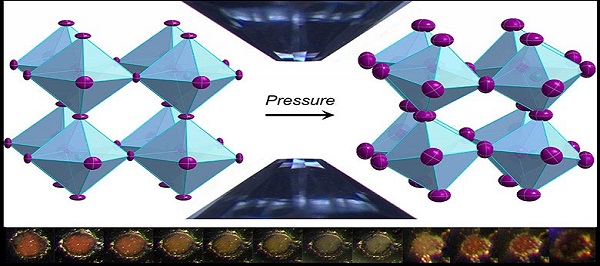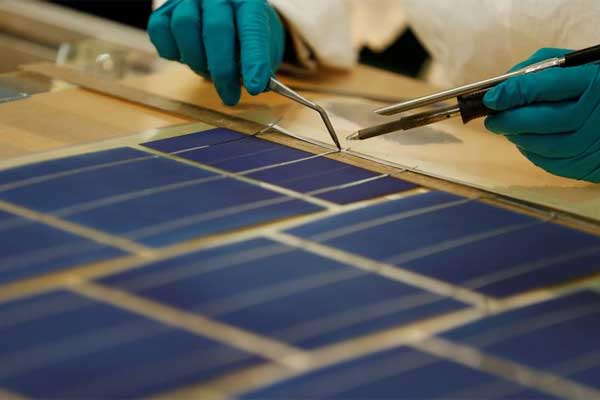Solar cells made of artificial crystalline structures called perovskites have shown great promise in recent years. Now Stanford University scientists have found that applying pressure can change the properties of these inexpensive materials and how they respond to light.
“Our results suggest that we can increase the voltages of perovskite solar cells by applying external pressure,” said Hemamala Karunadasa, an assistant professor of chemistry at Stanford. “We also observed a dramatic increase in the electronic conductivity of these promising materials at high pressures.”
Karunadasa and Stanford colleague Wendy Mao presented their findings in the April 6 online edition of the journal ACS Central Science.
Perovskites come in several crystalline structures, including hybrid perovskites made of lead, iodine or bromine, and organic compounds. The inexpensive materials have potential applications in advancing LEDs and lasers, but one of the hottest areas of research involves solar cells. Recent studies have shown that hybrid perovskites efficiently absorb sunlight and convert it to electricity. Several labs have achieved efficiencies above 20 percent, rivaling commercially available silicon solar cells.
In the ACS Central Science study, Karunadasa and Mao sought to assess how pressure affects the way hybrid perovskites respond to light. To find out, the researchers loaded perovskite samples in a diamond-anvil cell, a high-pressure device consisting of two opposing diamonds. Each tiny sample was placed between the diamonds and then squeezed at very high pressures.
The results were visible. One sample, which is normally orange, turned lighter in color under compression, an indication that the perovskite was absorbing higher-energy light waves. But as the pressure increased, the sample darkened, indicating that lower-energy light was also being absorbed.
“Our findings suggest that compression can allow us to tailor the wavelength of absorbed light,” said Mao, an associate professor of geological sciences at Stanford and of photon science at SLAC. “This compression may be attained through either mechanical or chemical means.”
Several research groups have been developing low-cost tandem solar cells made of perovskite stacked on top of silicon. But obtaining the high voltages required for high-efficiency tandem cells has proven difficult. The results of the new Stanford study suggest that pressure can increase the voltages of perovskite solar cells and should be investigated further.
“By tracking the positions of atoms upon compression using X-ray diffraction, we can explain exactly how the materials’ structure responds to pressure,” Karunadasa said. “Overall, this work shows that pressure is a tuning knob for improving the properties of perovskite absorbers in a predictable way.”
Other co-authors of the study are Adam Jaffe of Stanford, Yu Lin and Johannes Voss of SLAC National Accelerator Laboratory, and Christine Beavers of Lawrence Berkeley National Laboratory.
Funding was provided by the National Science Foundation, the U.S. Department of Energy, the Stanford Global Climate and Energy Project and the Stanford Interdisciplinary Graduate Fellowship program.
Reference(s):
Publication: Adam Jaffe, Yu Lin, Christine M. Beavers, Johannes Voss, Wendy L. Mao, Hemamala I. Karunadasa. High-Pressure Single-Crystal Structures of 3D Lead-Halide Hybrid Perovskites and Pressure Effects on their Electronic and Optical Properties. ACS Central Science, 2016
Story: Stanford scientists improve perovskite solar-cell absorbers by giving them a squeeze















Comments